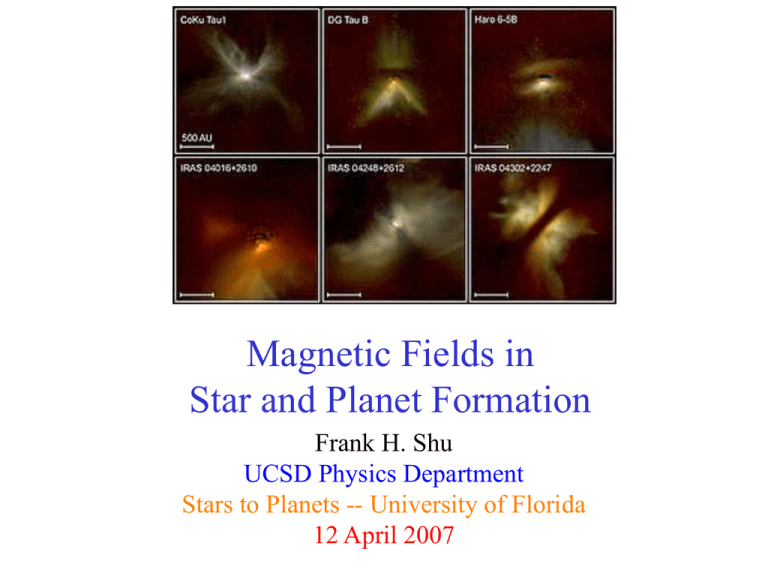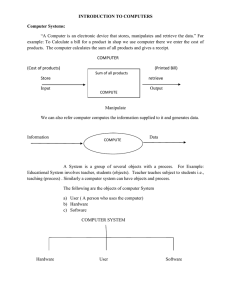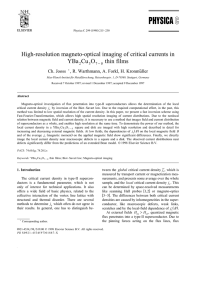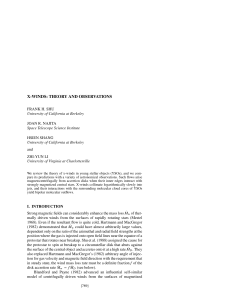Shu, F. (UCSD) - University of Florida
advertisement

Magnetic Fields in Star and Planet Formation Frank H. Shu UCSD Physics Department Stars to Planets -- University of Florida 12 April 2007 Outline and Logic of Talk • Cloud core characterized by dimensionless massto-flux ratio 2 G1/2 M / 1 to 2 collapses to form star + disk. • Some loss of flux during collapse results in 0 4 for system. Most of the mass ends up in the star; almost all of the flux, in the disk. Therefore, known mass of star implies calculable flux in disk. • Self-contained theory of MRI for viscous/resistive spreading yields disk radius R() needed to contain flux trapped in disk as function of age t. 3 1/2 • Predictions for ( ), Bz ( ), and f (GM * / ) with f < 1 (sub-Keplerian rotation) of disk. • Implications for disk- and X-winds, funnel-flows, and planetsimal formation. Catastrophic Magnetic Braking if Fields Are Perfectly Frozen Allen, Li, & Shu (2003) – Initial rotation in range specified by Goodman et al. (1993). Some braking is needed, but frozen-in value is far too much (no Keplerian disk forms). Ohmic Dissipation of Split Monopole Yields Central Region of Low Uniform Field rOhm 2 2GM * , sm 4G 5 / 2 M * Bc . 2 4 15sm 30 r Ohm 3 For 2 10 20 cm 2 s-1, split monopole 2, and M * 1 M⊙, sm 4G 5 / 2 M * Bc 2 15sm 4 30 rOhm 3 rOhm 8.4 AU, and Bc 1 gauss. Contours of constant FL/FG Magnetic field lines Shu, Galli, Lizano, & Cai (2006) NGC 1333 IRS 4A Best fit: split monopole 1 to 2 ROhm 50 AU 4 10 20 cm 2 /s for d 300 pc. Likely value in star plus disk: 0 4. Girart et al. (2006); Gonzalez et al. (2007) Mean-Field MHD of Accretion Disks in Star Formation Model equations: 1 u 0, t B Bz 1 2 2 2 B Bz B r GM 2 G K 0 (r,t)rdr , * 0 2 1 2 u [ ] , t Bz 1 1 Bz u B , t z0 where B 0 K 0 ( ) rdr r K 0 Bz (r,t) 2 1 2 — 1 z0 A and a 2 Lubow, Papaloizou, & Pringle (1994); Shu & Li (1997) 1 cos 2 2 cos 3/2 d 1 B 2 2 GM * GM * 2 A . A 2 Bz Shu, Galli, Lizano, Glassgold, & Diamond (2007) MRI Turbulence in Magnetized Accretion Disks No previous MRI simulation is both global • Turbulent viscosity: and has a nonzero net magnetic flux. Reason u B ~ B why MRI simulations systematically give too B ~ small aviscosity compared to astrophysical systems (cf. King, Livio, & Pringle 2007). with u ~ B with B ~ B . B B (B )2 Maxwell stress: ~ . 4 4 Cf. modeled viscous stress: . 2z0 (B )2 z0 identify F where F is "form factor." 2 Bz 2 z0 Shakura-Sunyaev In steady state, B I l Bz D 2 viscosity with where D I l 2 F is an order unity parameter. magnetic pressure • Turbulent resistivity: replacing gas pressure. 3z0 in quasi-steady state. 2I l Four Astronomical Models • Steady-state solution: 1/2 GM f 3* , 1/ 4 GM * M&*2 3 , f Il M&* . 1 f 2 3 DA (GM * )1/2 2f Bz 3DA 1/2 A( ) 0.1( / 100 AU)1/4 I l 1.742 M D (R ) M&*t age where 0 0 = 4 Bz 2 d 2 G1/2 M * / 0 0.5444 M * 1 f 2 0 2 M D (R ) T Tau LMP FU Ori HMP M* /M¤ 0.5 0.5 M* M ¤/yr 1x10-8 2x10-6 2x10-4 1x10-4 tage/yr 3x106 1x105 100 1x105 D 10-2.5 1 1 1 0.03 0.20 0.02 10 f 0.658 0.957 0.386 0.957 R/AU 298 318 16.5 1,520 JD (M¤ 5.12 51.4 0.473 39,700 0.5 25 . • Models: R Object MD /M¤ AU km/s) binary? binary? Magnetic Fields and Surface Densities Both LMP and TT have ~ 1 G field at 3 AU, compatible with chondrules in meteorites. LMP and HMP have several to tens of mG fields at 100 &1000 AU (check with masers) FU Ori has kG at 0.05 AU, compatible with measurement by Donati et al. (2005). These authors also find rotation to be sub-Keplerian by factor of 2 to 3, compatible with f = 0.386. Surface density of neither LMP nor TT looks like minimum solar nebula. The profile inferred from solids probably results from recycling of hot rocks near the protosun 3/ 2 (Stardust sample-return mission). Implications for X-wind/Funnel Flow/Planetesimal Formation • Inward press of disk field resisted by outward press of squeezed magnetosphere. • Change of magnetically coupled layers from subKepler to super-Kepler with change in sign of B Bz , i.e with change from outward bend to inward bend of field lines. (Inner edge helps.) • X-winds are better focused and faster with f < 1/3. • Planetesimals probably form only in dead zones Shu, Lizano, Galli, & Cai (2007)





